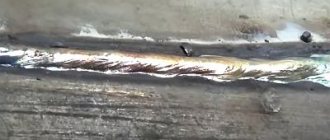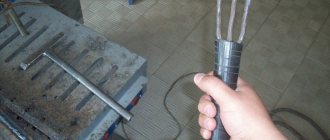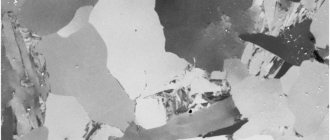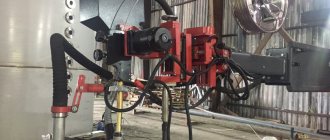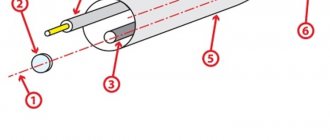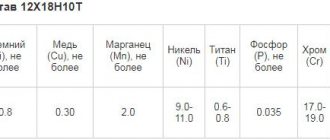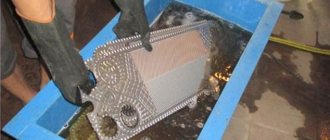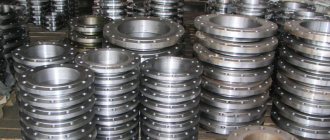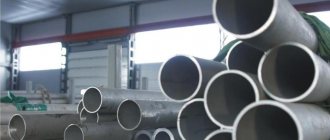The process of welding stainless steel with ferrous metal causes difficulties even for experienced craftsmen. This is due to the physical and chemical properties of the materials.
To create a strong weld, the correct choice of operating parameters of the apparatus, brand of electrodes, and filler wire is required.
Welding with electrodes on stainless steel
Welding corrosion-resistant steels is a complex and time-consuming process. This procedure requires the performer to have theoretical knowledge and practical experience. Another important criterion for comfortable welding work is the correct choice of electrodes.
The special characteristics of stainless steel, as well as several welding features of this material, require the use of special welding materials . Welding stainless steel with a properly selected electrode is a guarantee of reliability, strength and long service life of the finished product.
How to weld stainless steel with a regular electrode
Very often, novice welders ask themselves: can they weld stainless steel with conventional electrodes? It is important to note that welding corrosion-resistant steels with conventional electrodes is technically possible . In the absence or shortage of special welding materials, you can use simple consumables. Many craftsmen have repeatedly used this approach, but exclusively for processing parts for household use . Since increased requirements for reliability and solidity are applied to industrial structures.
From a technological point of view, it is recommended to use specialized electrodes with a suitable coating. Welding stainless steel with simple electrodes negatively affects the quality of the connection, and microcracks may also appear .
The question also often arises: is it possible to weld stainless steel using conventional welding? This also implies the possibility of using simple consumables for working with corrosion-resistant steels.
Video
We invite you to watch a short video where a DIYer shows how he welded the heat exchanger of a sauna stove with a black electrode. The comments show that opinions are divided on the admissibility of such welding, which makes this approach controversial.
Stainless steel welding methods
There are several methods for welding stainless steels. Each method involves the use of specific equipment and consumables. How to properly cook stainless steel with electrodes will be analyzed further.
Manual electrode
Manual welding of stainless steels with a coated electrode is universal and can be used in almost any industry. This method provides acceptable connection quality, so it is used by home and professional performers. Another important advantage of MMA technology is the simplicity and ease of the welding process. In addition, welding stainless steel with arc welding has several more advantages :
- affordability of electrodes and equipment;
- the devices can work throughout the working day;
- the units have compact dimensions and low weight, which allows you to quickly move around the work site;
- high speed of work with skillful handling of equipment and consumables;
- strength of welds;
- There is an opportunity to independently study this welding method and apply it in practice.
In order for a weld to be highly reliable, it is necessary to select the right welding materials. The following brands are suitable for manual welding:
OZL-8 are designed to weld products exposed to aggressive environments. At the same time, increased requirements for resistance to MCC are not imposed on the deposited metal. Performers use OZL-8 electrodes to process critical structures.
NZh-13 electrodes create a reliable connection and prevent the formation of ICC. A thin layer of slag crust disappears spontaneously after cooling and compression of the working area. This significantly speeds up the process when a large number of seams need to be completed.
TsL-11 electrodes are characterized by good insulation of the weld pool from external factors. This brand provides a strong connection.
When using this technology, direct current is used to weld stainless steel, the polarity is reversed.
After analyzing this information, a performer of any level will be able to learn how to weld stainless steel using arc welding.
Manual argon
Manual welding of stainless steel in an argon environment is carried out using tungsten electrodes. This technology guarantees high-quality and reliable seams. Moreover, the connections meet all the requirements, even if they are made at home. Consequently, argon arc welding is used when the performer needs an aesthetic result. The seams do not need to be cleaned of slag. There are no sparks during welding. This is the cleanest connection method . This method is also intended for working with parts with very thin walls.
Welding is carried out with alternating or direct current of straight polarity .
The type of stress depends on the thickness of the metal:
- if the thickness of the sheets being welded is 1 mm, then a direct current of 30-60 A is used, the diameter of the electrodes is 2 mm.
- welding of stainless steel with alternating current is also possible when working with elements 1 mm thick: voltage - 35-75 A, electrode Ø - 2 mm.
- data for processed products with a thickness of 1.5 mm:
- direct current of direct polarity, 40-75 A, Ø welding rod - 2 mm;
- alternating current, 45-85 A, Ø - 2 mm.
- thickness 4 mm.: direct current of straight polarity, 85-130 A, Ø - 4 mm.
- the arc should be ignited in a non-contact manner so that tungsten from the electrodes does not get into the molten metal;
- welding must be carried out without oscillatory movements of the rod. Violation of this rule may lead to a violation of the protection of the working area, which will lead to oxidation of the seam.
Features of this method:
Which welding technology is better to choose?
When deciding how to weld stainless steel to ferrous metal in a home workshop, welders prefer cheap methods. However, the most durable seam is obtained using expensive argon arc technology. Such equipment is rarely found in a home workshop. Purchasing the device is not advisable.
Inverters are cheaper. Stable operation and high strength of the resulting seam make this equipment preferable for home craftsmen.
Manual arc technology is only suitable for forming horizontal connections. When exposed to high temperatures, the steel melts and the weld pool moves.
Welding stainless steel with an electrode at home
To carry out welding at home, many performers use inverter-type devices.
Units of this type operate from a standard 200 V power source; their small dimensions and weight make it convenient to move and transport the equipment.
The relatively low cost has made this type of equipment a top seller among performers. Welding stainless steel using inverter welding creates a reliable connection.
When setting up the inverter, the following parameters should be taken into account:
- if the metal thickness is 1.5 mm, then the current should be 40-60 A, electrode Ø 2 mm.
- part thickness 3 mm: voltage 75-85 A, rod Ø - 3 mm.
- thickness 4 mm: current 90-100 A, rod Ø - 3 mm.
- thickness 6 mm. voltage 140-150 A, consumable Ø - 4 mm.
Welding is carried out with direct current of reverse polarity.
The welding process includes several stages:
- Rust, oil and other contaminants should be removed from the working surface , cleaning is carried out with a metal brush;
- The edges of a product whose thickness exceeds 4 mm must be cut. This ensures a good level of penetration and filling of the weld pool. Cutting is done with a grinder or file;
- when working with thin metal , you need to tightly bring the welded edges together and make tacks;
- product with a thickness of more than 7 mm. should be heated to 150°C. When carrying out household welding, it is recommended to do this with a blowtorch;
- work begins with igniting the arc. The electrode is brought to the surface and touched several times, thus activating it.
- connections are made on a short arc ;
- a “lock” should be made at the end of the seam to avoid the formation of cracks and fistulas;
- after finishing the welding process, you need to let the product cool, it is not recommended to do this forcibly;
- the slag crust is removed with a hammer or cleaned approximately five minutes after completion of work;
- The last step is polishing and grinding .
Read also: How to ring a chain in a car
Useful video
The technique of making a seam is well filmed close-up and shown in this video. There's no explanation, but it clearly shows what it looks like.
And one more video.
This method requires electrodes used to work with corrosion-resistant and heat-resistant metals.
Electrodes intended for inverter welding of corrosion-resistant steels:
The seam made with OZL-6 electrodes is heat resistant and not prone to the formation of cracks and pores. This brand is characterized by high performance properties.
ANO-27 electrodes are intended for welding critical structures operating under static and dynamic loads, as well as at negative temperatures.
How to prepare metal
The alloy can be welded using either a conventional arc or argon arc welding machine. However, regardless of the method, preliminary preparation of the workpieces is necessary. The process involves performing the following operations:
- Cleansing from impurities.
- When connecting thin plates (0.5-1.5 mm), it is necessary to press them tightly against each other.
- When welding parts with a thickness of more than 4 millimeters, it is necessary to cut the edges, which is necessary for better welding, since the seams are slightly wider and deeper. This is done using an angle grinder or a file.
- Set a gap of 1-2 millimeters.
- When joining parts longer than 7 millimeters, it is advisable to warm them up.
- For reliable fixation during work, it is recommended to use clamps or potholders.
- Start of welding.
What electrodes should be used to cook stainless steel with ferrous metal?
In production, where all processes are carried out exclusively in accordance with technology, most often the question does not arise: how to weld stainless steel to ferrous metal? After all, the connection of such different metals under normal conditions is incorrect, from a technical point of view . Also, the need for such a procedure, as a rule, is practically absent. But sometimes there is such a need. And for this purpose special electrodes are produced.
Also, at home, a process of this kind is quite possible. But to do this, you need to know the chemical composition of the products being welded in order to choose the right consumables . After all, stainless steel and ferrous metal are dissimilar materials. You should also take into account such a parameter as weldability, i.e. the ability of these materials to form permanent connections of satisfactory quality.
There are two ways to connect:
- welding of stainless steel and ferrous metal with a coated electrode;
- welding with tungsten consumables.
When using MMA technology, welding materials designed for non-ferrous metals and alloys should be used.
Welding electrodes ANZHR-2.
The most common brands are ANZHR-1 and ANZHR-2. The main advantage is the ability to carry out welding in almost all spatial positions, except vertical “top-down”.
TsT-28 electrodes are also a suitable option. Advantages: the seam formed using welding materials of this brand is characterized by high heat resistance and heat resistance.
In addition, the performer can use special stainless steel electrodes.
ESAB electrodes for welding dissimilar alloys are in demand among performers: OK 67.42, OK 67.45, OK 67.52, OK 68.81, OK 68.82, OK 92.26.
The second method is less popular due to the higher cost of tungsten electrodes. The performer will also need special welding equipment. During the welding process with this technology, it is necessary to carefully monitor the position of the rod. To obtain a high-quality and reliable connection, you need to hold the rod perpendicular to the surface of the products being welded.
Depending on the thickness of the materials, different currents and polarities are used when welding stainless steel:
- product thickness 1 mm: constant voltage, force 30-60 A, rod Ø - 2 mm;
- thickness of parts 2 mm: alternating current with a force of 50-80 A, rod Ø - 3 mm;
- thickness is 4 mm.: direct current, voltage - 90-130, consumable Ø - 4 mm.
Methods of welding ferrous metal and stainless steel
Manual and semi-automatic machines are used to join parts made of different metals. The process is carried out both with and without the supply of protective gas.
Semi-automatic machine
When using this technology, the elements to be connected require preparation. Before welding, perform the following steps:
- the areas adjacent to the future seam are cleaned with an iron brush to a metallic shine;
- chamfers are removed from the edges of thick workpieces;
- degrease surfaces with acetone, alcohol or gasoline;
- dry the edges by heating them with a burner;
- To eliminate internal stress, parts are heated to 200 °C.
For welding at home, a semi-automatic machine with a power of up to 10 kW is sufficient. Such devices are designed for joining workpieces up to 3 mm thick. When setting up the unit, the voltage is set to 19-25 V. The recommended supply speed of consumables is 300-400 m/h. The current strength is selected depending on the thickness of the metal. By increasing or decreasing this parameter, the degree of penetration, the length of the electric arc, and the shape of the seam are adjusted.
When working, observe the following rules:
- The process is carried out with a current of reverse polarity.
- The torch is installed at an angle to ensure the required penetration depth and width of the weld pool. The wire should protrude no more than 12 mm.
- Gas flow should be 6-12 m³/hour. To remove excess moisture, the substance is passed through a desiccant.
- The electrode is calcined at +200 °C before use.
- To protect adjacent areas from melt splashes, they are treated with an aqueous solution of chalk.
- Welding begins by retreating 5 mm from the edges of the parts. This prevents cold cracks from appearing.
- The electrode is guided smoothly along the connection. Transverse movements are unacceptable. The melt must not leave the protective environment.
How to cook with an electrode
Inverters are used to connect stainless steel and ferrous metal workpieces in domestic conditions. The devices are powered from a 220 V network; their compact dimensions make them easy to move. The welding process is carried out as follows:
- Clean the treated surfaces from rust, grease and dust. Clean the metal until it shines.
- The edges of thick workpieces are cut with a grinder or file. This ensures a high degree of penetration and filling of the weld pool.
- Thin-walled parts are compared and welded in several places. Products with a thickness of more than 5 mm are heated to 150 °C. At home, a blowtorch is used for this.
- Excites an electric arc. To do this, bring the electrode to the surface and touch it several times. Welding is carried out with a short arc.
- The welding is completed, forming a lock that prevents the appearance of cracks and burns.
- Wait for the seam to cool naturally. Coercive methods cannot be used.
- Clean the connection from slag using a hammer. Polish and grind the seam.
We recommend reading: How to weld stainless steel with electrodes
In a gas environment
The process is carried out using infusible tungsten electrodes. Due to the high cost of the work, the method is rarely used in home workshops. However, it helps to obtain the highest quality welded joint in comparison with other technologies. The argon method is used to repair damage in gas and water pipelines. Welding ferrous metal with stainless steel is carried out with direct current.
Gas begins to be supplied 5-10 seconds before the electric arc appears. The entry of air into the weld pool leads to oxidation and deterioration of the anti-corrosion properties of steel. During operation, zigzag movements of the electrode are unacceptable. They are capable of disturbing the gas space.
To protect the underside of the seam, blowing is used. After welding is completed, gas continues to flow for 15 seconds. This increases the strength of the seam.
Welding thin stainless steel
Welding thin metal requires a certain level of knowledge and skills from the performer. When working with thin-walled products made of corrosion-resistant steels, it is important not only to choose the right electrodes, but also to correctly determine the voltage. How to weld thin stainless steel with an electrode and what current is used to weld stainless steel will be discussed below.
Compared with ordinary steel, welding of thin stainless steel with an electrode should be carried out at a lower current . The number of amps required is approximately 20% less.
The diameter of the welding rod plays an important role. When the thickness of the welded product is 3 mm. diameter of the consumable is 3-4 mm.
Rods no longer than 35 mm should be used. The heating temperature should not exceed 500°C.
Household welding of thin stainless steel is carried out using an inverter. It is recommended to follow the following rules:
- do not heat the workpieces and the joint above a temperature of 150°C;
- the welding process is carried out at low current values at high speed ;
- without oscillatory movements of the electric arc;
- under the workpieces that will “take away” some of the heat . This will prevent the work area from becoming too hot and causing holes to form.
Metal up to 3 mm thick. cooked without cutting. There should be a gap of 1-2 mm between the workpieces.
When carrying out inverter welding using electrodes with a diameter of 3 mm, it is necessary to set the voltage to 80 A.
Craftsmen use the following grades of electrodes to connect thin corrosion-resistant steels:
TsL-11 is a common and popular brand of welding materials. The weld material deposited with TsL-11 is resistant to corrosion under unfavorable conditions.
OK 63.20 is intended for work with thin-walled elements operating in contact with liquid aggressive non-oxidizing media at temperatures up to 350°C.
MMA welding
Question No. 1.
Does the inverter cook stainless steel? Yesterday I decided to try my luck. I took a round tank from a washing machine and went to a friend who has an inverter. I tried to cook with a stainless steel electrode, 3 mm in diameter. The arc jumps, it is impossible to work. If you add current, the arc breaks. There are metal burns in the tank.
Welding inverter Aurora
Answer:
To weld corrosion-resistant steels, you need an inverter with a built-in oscillator or with a “well-rectified” current. The passport that comes with the inverter usually indicates what metals it is designed for. But even if you do not find the required information in the passport, you can always find out all the capabilities of the device in a specialized store. Tig welding is best suited (in particular, the Aurora PRO INTER TIG 200 PULSE welder is popular). ADS allows you to make high-quality seams on thin-walled sheets and parts (pipes, for example). Joining a thin sheet (up to 3...5 mm) using manual arc welding and obtaining a high-quality seam is not an easy task. Metals that are resistant to corrosion usually contain a lot of chromium, and this, in turn, forms oxides with oxygen in the air, which often leads to cracking of the seam over time. Scale is formed. Therefore, it is important, when performing delicate work on products for which high demands are placed, to blow the back side of the seam with argon.
To work with a piece electrode with flux coating, experience is required. You need to play with the polarity, and not just work according to the instructions. With thick-walled products, as mentioned above, there are usually no problems. But do you know so many products or structures made of thick stainless steel? That's right, everything that is found is relatively thin-walled, up to 5 mm thick in cross-section.
When you cook thin-walled stainless steel, you have to get out of it:
- The currents must be set as low as possible and the arc kept as short as possible.
- The arc is ignited to the side and then gradually brought to the edge to be welded.
- Pay attention to the connection of the ground terminal, arc blowing will act in its direction.
As for burns, for thicknesses of 1 mm you need an electrode thinner than 3 mm. To ignite a three-millimeter electrode, you need a current that will instantly burn through a thin sheet. It is not easy to weld “ferrous” metals with a “troika” electrode, but with stainless steel, and even in order to learn, you need to take a 2 or 1.6 mm electrode. Stainless steel with a low carbon content is best welded. Due to the fact that steels with a high chromium content are prone to stress concentrations that are an order of magnitude higher than those in carbon steel, temperature changes must be avoided.
Preheating to 200 -350 degrees Celsius is recommended.
Key features you need to know:
- Corrosion-resistant metals have extremely low thermal conductivity. This means that heat is transferred into the surrounding air space slowly, and the rate of formation of the weld pool increases. For this reason, welding is performed at low currents. If for carbon steel of a certain thickness you needed to install 80A on your device, then for a similar stainless steel you will need 60A. The current strength is reduced on average by 25%.
- linear dimensions undergo significant changes when heated, which is due to the considerable value of the coefficient of thermal expansion. The consequence is large leads of parts. If we are talking about welding thick-walled parts into a joint without a gap, such a connection is guaranteed to crack. The reason for this is the high voltages of such a connection, which arise due to the uneven expansion of the metal. For large thicknesses, perform butt welding with a gap.
- A large number of alloying elements increases the electrical resistance, so in MMA they work with electrodes no more than 350 mm in length.
- Strictly follow the heat treatment regimes recommended for a particular brand, due to the tendency for intergranular corrosion to occur.
MMA electrodes for stainless steels
Question No. 2. There is an inverter for RDS (MMA) in the garage. There is work on welding stainless steel. Tell me which electrodes are suitable for this type of work and which are not. What are the pitfalls of welding with certain electrodes?
The choice of electrodes for stainless steel really requires the proper approach. Fortunately, their range is quite wide. The best electrodes for corrosion-resistant steels today are OK61.30. They are produced by the Swedish company ESAB and are successfully used in welding 12Х18Н10, 12Х18Н10Т, 08Х18Н10, etc. OK61.30 with rutile coating have easy ignition, hold the arc confidently, provide optimal heating, i.e. perform very well. The slag is separated perfectly. Domestic electrodes mostly come with a base coating. They are quite capricious and require a certain skill from the welder (they have a tendency to stick, when the arc is ignited, the coating often peels off, and they can suddenly stop working), but the seam they make provides high corrosion properties. The brands TsL-11 or OZL-8 are often found on sale.
Question No. 3 How to cook TsL-11 correctly?
Answer:
Like ESAB OK61.30, TsL-11 electrodes are manufactured for critical-use structures made of steels containing Cr and Ni, such as 12Х18Н10Т, 12Х18Н12Б, etc., which will work in difficult conditions when great demands are placed on them. The welds produced by TsL-11 are highly resistant to corrosion between the crystals.
Before welding work, the parts are cleaned with a brush to a metallic shine, dirt, oil, and corrosion are removed, which, despite the fact that it is stainless steel, can manifest itself. You should try to keep the arc as short as possible, and form the seam with narrow rollers. For electrodes up to 4 mm, DC current and reverse polarity are used. Cook in any position except “from ceiling to floor”. If the diameter is four millimeters or more, difficulties arise with passing seams on the ceiling and vertically. Due to the low content of “harmful elements” and low gas formation, TsL-11 produces a seam that is resistant to normal corrosion and between crystals. If the electrodes have been lying in a damp room for a long time and have gained moisture, heat treatment of about 200 degrees Celsius is required for an hour.
Welding of stainless steel pipes
Welding stainless steel pipes with electrodes is a popular type of joining such products. Welding work with pipes is carried out using electrodes with basic or rutile coating. The welding process with a consumable consumable is carried out using direct current of reverse polarity.
Welding stainless steel with direct current has several advantages: low metal spattering; simplicity of the process for the welder; suitable for working with thin-walled pipes; high quality seam.
Tungsten electrodes for welding stainless steel pipes operate on direct current of straight polarity. Advantages of this method:
- reliable protection against exposure to oxygen, which can lead to oxidation;
- stable arc;
- the connection has high corrosion resistance.
Regardless of the chosen connection method, the technology for welding stainless pipes includes three stages:
- The preparatory part is divided into two parts: preparation of the performer and preparation of the main material. The welder must be provided with special clothing and a protective mask. Stainless steel pipes need to be cleaned of various contaminants : corrosion, paint, etc. The joints and the area around them should be treated with a wire brush or sandpaper.
- The welding process begins with ignition of the electrode and initiation of the arc. It is important to hold the arc during the work. Then the connection is made.
- An important step is checking the quality of the seam . Before this, it is necessary to beat off the slag.
Electrodes for stainless steel pipes:
OK 63.20 are intended for spot welding, i.e. the process is carried out by briefly igniting and extinguishing the electric arc.
A short video for clarity.
Welding with coated electrodes (MMA)
Welding stainless steel parts using MMA technology, which involves the use of coated electrodes, is the most common technology. This method is quite simple, it can be used at home, but it does not allow you to obtain the highest quality seam.
Conveniently, this kind of stainless steel welding can be done even at home, but for this you will need a special welding machine called an inverter. In order for welding stainless steel with an inverter to produce a highly reliable connection, it is necessary to select the correct electrode for a specific grade of stainless steel. All electrodes used to weld stainless steel products are divided into two main types:
- with a rutile coating based on titanium dioxide (welding with such electrodes, which provide small metal spatter and a stable arc, is performed with direct current and reverse polarity);
- with a coating based on magnesium and calcium carbonate (with such electrodes, stainless steel is welded using direct current of reverse polarity).
To understand which electrodes to use to weld stainless steel, just look at GOST 10052-75, which presents all types of such consumables, and also stipulates which one should be used for working with metal of a specific chemical composition. In order to select stainless steel electrodes that meet the requirements of this GOST, it is enough to know the grade of the metal from which the parts need to be connected.
All requirements for electrodes for welding stainless steel can be found by downloading GOST 10052-75 for free in pdf format from the link below.
GOST 10052-75 Coated metal electrodes for manual arc welding of high-alloy steels with special properties
Welding modes
When choosing the optimal mode for working with corrosion-resistant steels, performers have the following questions: what current should be used to cook stainless steel and what polarity should be used to cook stainless steel?
Various devices are used to work with corrosion-resistant steels, but the best option are those that operate on direct current .
In the absence of direct current, an inverter should be used that is capable of converting the type of voltage. Using the appropriate type and diameter of welding consumables ensures a quality connection.
However, it should be remembered that each specific situation requires the use of certain consumables and units.
Therefore, to learn how to properly weld stainless steel with electrodes, you should familiarize yourself with the above-mentioned relevant information.
Among the many steels, according to some sources, their total number is about 600 items, stainless steels (corrosion-resistant) stand out. The composition of these steels allows them to be used in various operating conditions, for example, in sea air or in chemically aggressive environments.
Stainless steel is used to produce pipeline fittings, containers, including those operating under pressure, and many other parts and assemblies. To connect parts of the pipeline to each other, a detachable or permanent connection is installed. For the first type, flanges, couplings, etc. are in demand. Welding is used to create permanent connections (joints).
It must be understood that the presence of various elements in the composition of stainless steels places special demands on the joining method and the materials used for this.
Read also: Characteristics of the welding machine Resanta Sai 220
Why is it important to use special electrodes for welding stainless steel?
Stainless steel, since its appearance on the metal market, has been widely used for the production of parts and assembly units that are used in various industries. The popularity of stainless steel is due not only to its resistance to corrosion, but also to a number of other properties. These include high strength parameters, appearance, and durability. But alloys of this class have one significant drawback - poor weldability. It must be said that this drawback significantly complicates working with stainless steel. This is due to a number of reasons, in particular:
- Stainless alloys have low thermal conductivity. This figure is two times less than that of traditional carbon steels. That is why, during welding work, this material is less able to remove excess heat generated during the work process. This phenomenon has led to the fact that in order to reduce heat, a welding current that is 15-20% less than that required for welding ferrous alloys is used.
- When joining stainless steel products with a large mass, a fairly large gap must be left between the workpieces. If this requirement is ignored, microscopic cracks will appear in the metal located next to the seam. Their presence will lead to a reduction in the quality of the connection, including its reliability.
- When welding stainless steel, a high electrical connection zone is formed in the weld area. Accordingly, this leads to strong heating of the tool. This is what determined that to perform welding work it is necessary to use special stainless steel consumables designed to work with such steels. They are selected based on the markings on the box or on the consumables themselves.
Welding process
The most commonly used rolled steel: sheet, pipe, rod, angle. The approach to them in welding production is approximately the same. The quality of the finished product depends on the following aspects:
- Use of equipment capable of maintaining a stable process. For any stainless steel, it is important to observe the circuit, voltage, additive supply, etc. The latest generations of semi-automatic welding machines using inverters are optimal.
- Assignment of correct welding modes.
- Preparation of the material surface: degreasing and cleaning immediately before welding.
- Materials. Given the good thermal conductivity and susceptibility to thermal deformation, protective gas mixtures based on argon are optimal. This inert gas provides local heating and deep penetration over a relatively small area. The choice of welding wire is selected according to GOST. The content of alloying elements at the joint should not be lower, as well as its physical properties. It matters what AISI 304 is connected to – that’s one thing. If it is carbon steel, and another if it is high-alloy steel.
- Final operations. It is advisable to allow the finished product to cool in a fixed state - this will reduce the scale of deformation.
Stainless steel electrodes, what are their features?
When performing work with workpieces made from stainless steel, it is necessary not only to choose the right electrodes, but also to use welding equipment skillfully, in particular, to select the operating current, determine the gas flow, etc.
Electrodes for stainless steel welding
Violation of certain technological rules leads to such a phenomenon as intercrystalline corrosion. It reduces the corrosion resistance of the weld and adjacent metal. In addition, upon reaching a certain temperature, chromium and iron carbides begin to form in the structure. They make the metal excessively brittle and reduce its anti-corrosion characteristics.
Electrodes for stainless steel help to avoid this phenomenon, and if used correctly, the quality of the seam will meet all technical requirements.
Why is it difficult to weld stainless steel?
Welding stainless steel is complicated by the fact that it is a high-alloy alloy, which has a significant content of components that affect the basic properties. In this case it is chrome. The content of this material in the alloy can reach 30%. Chromium, like nickel, titanium, manganese and molybdenum, provides anti-corrosion protection, but at the same time affects other properties that reduce the level of weldability.
Welding work on stainless steel must take into account the following characteristics of the alloy:
- High coefficient of linear expansion. This property always leads to significant deformation of the elements being welded. In situations where thick parts are connected and no clearance is provided, deformation can contribute to the formation of large cracks.
- Low thermal conductivity. This characteristic is up to 2 times lower than in the case of low-carbon alloys. This property leads to through penetration of parts (especially thin ones) even at low current strengths.
- Intercrystalline corrosion. In the process of significant heating (more than 500°C) such a process occurs in stainless steel. It is characterized by the fact that a layer consisting of chromium and iron carbide appears in the metal structure. This factor is eliminated by careful selection of welding modes and additional cooling of the joined elements, for example, with water. But it should be taken into account that it is possible to use water for cooling only in the case of processing chromium-nickel steel with an austenitic structure.
There is another negative factor that affects work performance. Low thermal conductivity and increased electrical resistance contribute to strong heating of electrodes with a chromium-nickel composition. To eliminate this negative effect, it is necessary to cook stainless steel with appropriate electrodes up to 35 centimeters long.
AC or DC
To create permanent connections from stainless steels, it is permissible to use direct and alternating current. Each welding technology has certain pros and cons.
Thus, the use of direct current leads to a reduction in the consumption of electrodes, due to the fact that when using this current, the material practically does not splash. In addition, direct current allows for high welding speed and quality of the weld. But the equipment used for the work is highly expensive, and this, as a result, leads to an increase in the cost of work.
The use of alternating voltage allows the use of equipment that costs significantly less than that used to generate direct current. A welder using alternating current results in a high-quality weld. But, at the same time, the use of alternating current leads to the production of more drops of metal, and this leads to increased consumption of stainless steel.
DC electrodes on stainless steel
Before starting welding work, the welder must make the correct choice of electrodes. It should be understood that coated rods can guarantee high quality seams. Manual welding is performed using direct current of reverse polarity. To obtain a high-quality result, welders use the following brands of consumables intended for stainless steel:
- TsL11 is one of the most widely used brands among welders. It is used for processing steels with a fairly high content of chromium and nickel. The weld produced using this material has high strength and impact toughness. There is virtually no metal spattering during operation.
- OZL8 - suitable for assembling structures subject to operation at temperatures up to 1000 ⁰C. Its remaining parameters are close to the TsL11 brand.
- NZH13 – this grade is in demand when processing food grade stainless steel products. In addition, this consumable is intended for joining products with a high content of chromium, nickel, and molybdenum. The disadvantage inherent in this brand is the formation of slag, which spontaneously flakes off and thus can cause damage to the worker or people around him.
In fact, in practical work, several brands of electrodes are used that are designed for welding with stainless steel. Among them are the following:
- ZIO-8, which is used for products made of heat-resistant stainless steels.
- NII-48G is in demand in the manufacture of critical structures.
- OZL-17U are suitable for parts that will be operated in an atmosphere with a high content of sulfuric or phosphoric acid vapors.
AC electrodes for stainless steel
Not all organizations can afford technological equipment that operates using direct current. But you can also use equipment that uses alternating voltage. To work effectively with it, the following brands are used: OZL-14, LEZ-8, TsT-50, EA-400, OZL-14A, N-48, ANV-36.
In addition, the use of tungsten rods for welding stainless steel parts under a cloud of protective gases allows the use of alternating current with straight polarity. This technology is used for:
- connecting parts with a thin wall;
- there are increased requirements for the quality of the weld.
The practice of welding stainless steel products suggests that the use of alternating current is less popular, and accordingly, rods of this type are less in demand.
Types of stainless steel
Industrial and household welding of stainless steel sheets and profiles requires the correct choice of working method. It is determined by the type of metal. Based on its main properties, stainless steel is classified into:
Austenitic is named after the main phase. These are alloys with a high content of chromium and nickel. An example is the well-known food steel AISI 304 (08Х18Н10 according to GOST), which is actively used in the manufacture of tableware, various architectural details, chimneys, spoons and forks. Contains 18% chromium and 10% nickel. Austenitic steels are non-magnetic, ductile, chemically resistant and mechanically strong.
Martensitic steels are distinguished by their specific internal structure, visible under a microscope. They are characterized by a low carbon content (hundredths of a percent) and chromium up to 12%. Metals are very hard, but brittle, and are used for the manufacture of cutting tools or household items, turbines and fasteners that are used in slightly aggressive environments. Widely used in the production of alcoholic beverages. After heat treatment, the required impact strength and heat resistance are obtained.
Electrodes for stainless steels and ferrous metals
The combination of stainless steel and ferrous metal is quite possible. But this process is fraught with certain difficulties. The thing is that these metals have different structures. There are three methods you can use to perform this operation:
- welding using coated consumables;
- welding with non-consumable tungsten rods;
- welding under protective gas, as a rule, argon or gas mixtures based on it are used for this.
For welding dissimilar metals, the OZL-312 grade is used. To perform the assembly of critical structures, EA-395/9 is used. OZL-312 stainless steel welding rods are suitable for welding steels with an unidentified composition.
But, as practice shows, no one has come up with an optimal quality seam better than joining workpieces under gas protection. In this process, gas plays the role of protecting the weld pool from the effects of the atmosphere, in particular from nitrogen and oxygen. When welding with argon, there is one subtlety. To ensure the quality of welding, a welding rod is used, which must be held strictly at an angle of 90 ⁰ to the surfaces being processed.
Based on the above, we can draw the following conclusion: materials of wide application are used to perform welding of dissimilar metals.
Classification of stainless steels
The process of welding stainless steel is considered more complex than welding conventional steel products. This is due to the unique microstructure of the metal, which depends on the predominant crystalline phase. The presence of one or another component leads to a different reaction to heat treatment, so the choice of welding method largely depends on the class of material.
- Austenitic class. In such an alloy, the main phase is austenite. Additional elements are usually chromium (up to 20%) and nickel (up to 10%). Chrome promotes anti-corrosion, and nickel promotes ductility, which allows this material to be used in mechanical engineering. During heat treatment, austenitic alloys do not lose their characteristics, therefore they tolerate the welding process well.
- Ferritic class. The main phase in this case is ferrite. The addition of chromium gives the product anti-corrosion properties, however, unlike the austenitic alloy, the ferritic alloy does not have much flexibility. The main feature of ferrites is their increased resistance to aggressive environments, which is why this material is often used in the chemical industry. However, its resistance to ultra-high temperatures makes it inconvenient for welding.
- Martensitic class. The presence of martensite as the main phase gives the metal increased hardness. Martensitic alloy is mainly used for the manufacture of wear parts and cutting tools (knives). At the same time, the material is quite fragile, this must be taken into account during its processing and operation.
Read also: Connecting an LED strip in the kitchen via a switch
Electrodes for welding stainless steel 12×18n10t
Steel 12×18N10T is classified as an austenitic type material. This steel is widely used for the manufacture of equipment for the food and pharmaceutical industries.
The following types of products are used to connect workpieces made of this steel:
- TsL-9, welding with its use can be performed in all spatial positions.
- OK 61.30, ensures weld quality and self-peeling of slag.
What electrodes should be used to cook 1 mm stainless steel?
One of the most difficult processes in welding processes is processing parts with thin walls. This is because:
- Excessive heat generated during welding can cause a hole to form.
- High temperatures may cause surface deformation.
- The electric arc, which is used when processing thin-walled parts, is small in size. Even a small separation of it from the surface of the workpieces being processed can lead to its disconnection.
Read also: Diagram of a thyristor welding machine
Welding steel 1mm
All of the above difficulties significantly complicate the work of the welder. The correct choice of welding material can help eliminate these problems. For example:
- OK 63.34 - can be classified as universal electrodes; they can be used to work with workpieces of different thicknesses.
- OK 63.20 - they are used for processing pipes and thin-walled material.
Popular electrodes for stainless steel welding
The most popular electrodes for stainless steel include those produced by the world's leading manufacturers. The use of branded products guarantees a high-quality weld.
This Swedish company is a recognized leader in the development and manufacture of welding equipment and consumables used to work with various types of metals.
Its enterprises produce brands such as:
- OK 61.35 - they are used for welding particularly critical structures, for example, pipelines operating under pressure.
- OK 67.72 - electrodes used for welding dissimilar metals.
TsL 11
Electrodes of this brand are used to work with such alloys as 09×18N12T, 12×18N10T, ×14G14N3T and their analogues.
The key advantage of this consumable material is that the seam made with this electrode successfully resists intercrystalline corrosion.
MONOLITH
This is a domestic company that produces electrodes used for welding carbon and stainless steels.
Electrodes produced under this brand are used for working with both carbon and stainless steel.
If you find an error, please select a piece of text and press Ctrl+Enter.
Among all the varieties, stainless steel welding stands out in a special way. The fact is that with the usual process, a bath with hot metal turns out to be moderately viscous, which ensures a clear formation of the seam. It also makes vertical and overhead seams relatively easy to make. But when stainless steel comes into play, a number of nuances arise. After all, the bath turns out to be very fluid, as if there was water in it. This creates difficulties not only when forming ceiling and vertical seams, when the metal simply flows off the surface, but also ordinary ones. Even when welding stainless steel with alternating current in a horizontal position, there is a big risk that everything will spread. This requires clear and careful movements to form a high-quality seam.
Due to the increased fluidity, it becomes difficult to form welding “scales” on the seam, therefore, before welding stainless steel with an electrode, you should gain experience in this matter.
Welding AISI 304 in industrial conditions
You can place an order by phone
Our specialists will be happy to help you
Welding AISI 304, like any other stainless steel, requires a certain approach and appropriate equipment. The main objective of the process is to obtain a compound whose properties will exceed the base metal and have certain geometric parameters.
Welding methods
There are several ways to weld stainless steel using electric welding. They involve the use of various tools and additional consumables. There are three main ones, which are used both in domestic and industrial settings:
- Welding using coated stainless steel electrodes, which is universal and can be used in almost any field. In this case, the electrode forms the material for the seam.
- Welding with a tungsten electrode using argon shielding gas. An infusible electrode is used here, which melts the metal of the workpiece itself, which serves as the main material for forming the seam.
- Electric arc argon welding, which uses stainless wire instead of an electrode. The wire is supplied uncoated, and its functions are performed by argon shielding gas.
Argon welding
TIG welding with a tungsten electrode in an argon environment is often used for stainless steel.
At home, it is more convenient to cook with such a device than with a coated electrode, but not every master has a device capable of performing such work. The argon welding method is used for thin sheet metals and pipes that will be operated under pressure. The device operates on alternating current or constant reverse polarity. You will also need filler wire and a gas cylinder for welding. As a rule, if you have a machine with TIG welding capability in your garage or home workshop, then there are all the necessary fixtures and accessories. Compared to MMA welding, argon welding gives more predictable results.
